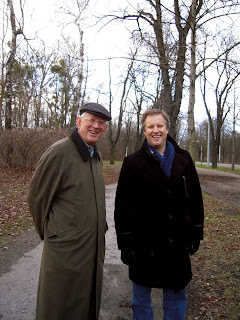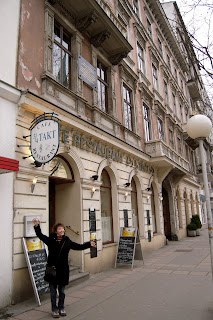 Leoben, Austria is nestled in a rich river valley, surrounded by gently rolling hills. Rather than an uninterrupted block of habitation, Leoben’s neighborhoods lie in the many pockets of land that are interspersed by the bends of the Mur River, which flows back and forth, back and forth, in a serpentine pattern. The three main sections of town are connected by bridges for pedestrians – and if you really must drive an automobile, a ribbon of highway skirts the south and east edges of Leoben.
Leoben, Austria is nestled in a rich river valley, surrounded by gently rolling hills. Rather than an uninterrupted block of habitation, Leoben’s neighborhoods lie in the many pockets of land that are interspersed by the bends of the Mur River, which flows back and forth, back and forth, in a serpentine pattern. The three main sections of town are connected by bridges for pedestrians – and if you really must drive an automobile, a ribbon of highway skirts the south and east edges of Leoben. 
We love to "wander," the inviting Austrian method of of hiking, walking in the woods, with a rest or a snack or two along the way.

Guten Morgen Spring Chickens!

Doesn't this look like a tempting stop for refreshments?
During the first weekend of March, Spring was doing its darnedest to make an entrance in der Steiermark. We also made an entrance to our second Austrian home with our hiking shoes, eager to take advantage of a gorgeous day. Our trek led us through happy farms, and greening meadows. Then as we climbed higher, we were met by melting ice and snow, which sometimes turned our hiking into skating. After a few morning “wanderen” hours, we made our way through the woods and came upon an adorable farm and gasthaus. We enjoyed a delicious lunch and the jovial company of the proprietors and the many locals soaking in the Sunday sun.

It looks like the middle of a farmer's barnyard - and it is - but when you walk down this path you enter a magical land of eats and drinks!
Sated, amused, and feeling adventurous, we ascended the hill in another direction, and then descended on another side. Then we went up a neighboring hill and down yet a different direction. Imagine our surprise a couple of hours later when we reached a clearing to realize we had hiked to the faaaaaaaaaar edge of town – we had actually reached the next village. It was about 4:30, starting to get dark, and the hill we were on was surrounded either by a highway and/or the river. From our bird’s eye view we saw exactly where we needed to go, and it appeared we might be able to successfully scamper down, but once down, how in the world would we get across the highway?
You know what happened to Hanzl and Gretel when they got lost in the woods?! We were determined this fate would NOT befall us. So, with the sun sinking, we did what any good Austrian would never do – we climbed over and under fences on to private property. (Well, an Austrian probably wouldn’t get lost in the first place.) Our thinking: where there is pasture, there must be a farmer. Sure enough - we unintentionally frightened the diligently working Austrian farmer when we simultaneously apologized for trespassing and asked for directions. Though we were still some distance from our goal (Mutti Theisl and her waiting kuchen), the kindly farmer assured us we’d make it UNDER the highway (those clever Austrians), into town, and to Mutti’s doorstep before sunset. Thanks to his precise directions, the nice farmer was right. After Mutti spoiled us, she sent us back to our most excellent Leoben lodgings where we slept like Austrian rocks.
The next day we gave a presentation at the monthly meeting of the upper Steiermark English Circle, chaired by our dear friend, Professor Frau Doktor Augustin. The greatest adventure in the two+ hours we spent with this pleasant group of community and university leaders was navigating the lively and extensive question and answer period – Gott Sei Dank because we were exhausted from the previous day’s quest. The hills and the English Circle have been calling, so we’ll make another visit later this Spring.





Who is the dog and who is the pony in this show? We'll let you decide.

Mutti Theisl (in the purple), and her friends Krista (in the grey) and Tony (our photographer), attended our presentation. Please keep in mind, Mutti doesn't speak any English.

Appreciation given in the form of Austrian chocolate - always a winner.

Mutti sees us off at the Bahnhof. Each time we depart Leoben she hands us a real Austrian Jause (think hearty sack lunch) for our 2-hour trip home to Vienna. She'll add "well, you just don't know when a beer or a salami sandwich may come in handy."













